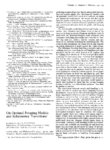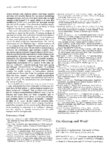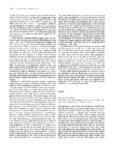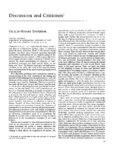|
|
Creator | Title | Description | Subject | Date |
| 26 |
 |
Rogers, Alan R. | Doubts about isonymy | The method of isonymy, developed by Crow and Mange for estimating inbreeding from surname frequencies, requires an assumption that has not been appreciated: It is necessary to assume that all males in some ancestral generation, the founding stock, had unique surnames. Because this assumption is sel... | | 1991 |
| 27 |
 |
McCullough, John M. | Relatedness and kin-structured migration in a founding population: Plymouth colony, 1620-1633 | To test the common assumption of no genetic relationship in a founding population, we calculated average relatedness (r) for the emigrants to Plymouth Colony from Europe on seven voyages from 1620 to 1633. Of 355 individuals, 255 could be individually identified and 4 generations of genealogic depth... | | 1991 |
| 28 |
 |
Rogers, Alan R. | Quantitative genetics of sexual dimorphism in human body size | A classical data set is used to predict the effect of selection on sexual dimorphism and on the population means of three characters--stature, span, and cubit--in humans. Given selection of equal intensity, the population means of stature and of cubit should respond more than 60 times as fast as d... | Societies; Selection; Species | 1992 |
| 29 |
 |
O'Rourke, Dennis H. | Patterns of genetic variation in native America | Allele frequencies from seven polymorphic red cell antigen loci (ABO, Rh, MN, S, P, Duffy, and Diego) were examined in 144 Native American populations. Mean genetic distances (Nei's D) and the fixation index FST are approximately equal for the North and South American samples but are reduced in the... | Gene frequencies; Amerinds; Genetic Distance | 1992 |
| 30 |
 |
Hawkes, Kristen | On optimal foraging models and subsistence transitions | Layton, Foley, and Williams are right: "progress" doesn't explain transitions from hunting and gathering to agriculture, by theory and models from behavioral ecology might. | | 1992-01-01 |
| 31 |
 |
Hawkes, Kristen | On sharing and work (a comment on Bird-David) | Bird-David (CA 33:25-47) discusses reasons for the persistent vitality and wide appeal of Sahlins's influential characterization of hunter-gatherers as representatives of 'original affluence." | | 1992-01-01 |
| 32 |
 |
Hawkes, Kristen | On why male foragers hunt and share food: Reply to Hill and Kaplan | My argument is this: Some food resources, notably large animals when they are unpredictably acquired, are too expensive to defend. Other can claim shares of them without repaying shares of the same foods later. | | 1993-01-01 |
| 33 |
 |
O'Rourke, Dennis H. | Biochemical heterozygosity and morphologic variation in a colony of papio hamadryas hamadryas baboons | This analysis examines the association between genetic heterozygosity and individual morphologic variation in a captive population of Papio hamadryas hamadryas consisting of 403 juveniles and adults. The population structure of the colony was artificially generated and maintained and is thus rigoro... | Population genetics; Polygenic; Inbreeding | 1994 |
| 34 |
 |
Rogers, Alan R. | Is migration kin structured? | We estimate the strength of kin-structured migration in six human populations (five from New Guinea and one from Finland) and in one population of nonhuman primates. We also test the hypothesis that migration is not kin structured by generating a sampling distribution of the estimator under the null... | | 1994 |
| 35 |
 |
Rogers, Alan R.; Jorde, Lynn B. | Founder effect: assessment of variation in genetic contributions among founders | We present a Monte Carlo method for determining the distribution of founders' genetic contributions to descendant cohorts. The simulation of genes through known pedigrees generates the probability distributions of contributed genes in recent cohorts of descendants, their means, and their variances. | | 1994 |
| 36 |
 |
Rogers, Alan R.; Harpending, Henry C. | Mismatch distributions of mtDNA reveal recent human population expansions | Although many genetic studies of human evolution have tried to make distinctions between the replacement and the multiregional evolution hypotheses, current methods and data have not resolved the issue. However, new advances in nucleotide divergence theory can complement these investigations with a ... | | 1994 |
| 37 |
 |
Broughton, John | Size of the bursa of fabricius in relation to gonad size and age in laysan and black-footed albatrosses | Age determination can be difficult for birds that undergo little or no plumage change during life. This is the case for Laysan and Black-footed Albatrosses (Diomedea immutabilis and D. nigripes). The juvenile plumage for both these North Pacific albatrosses is completely grown by about five to six m... | Birds; Species; Development | 1994 |
| 38 |
 |
Rogers, Alan R.; Jorde, Lynn B. | Genetic structure of the Utah Mormons: comparison of results based on RFLPs, blood groups, migration matrices, isonymy, and pedigrees | The genetic structure of the Utah Mormon population is examined using 25 blood group and 47 RFLP alleles obtained from 442 subjects living in 8 geographic subdivisions. Nei's Gst was 0.013 (p < 0.002) for the RFLP data and 0.012 (p > 0.4) for the blood group data, showing that only 1% of the geneti... | | 1994 |
| 39 |
 |
Hawkes, Kristen | On life history evolution (a comment on Chisholm) | Chisholm (CA 34:I-24) is right that the theory, models, and data of evolutionary biology apply to questions asked by social scientists. Work in life-history theory (Stearns 1992, Roff 1992, Charnov 1993) has especially provocative implications for the understanding of human development (see review i... | | 1994-01-01 |
| 40 |
 |
Rogers, Alan R. | Evolution of time preference by natural selection | This paper entertains the hypothesis that human time preferences are in evolutionary equilibrium (i.e. that no mutation changing time preferences could be favored by natural selection). This hypothesis implies that the marginal rate of substitution (MRS) holding Darwinian fitness constant must equal... | Capitalism; Econometric models; Equilibrium | 1994-06 |
| 41 |
 |
Hawkes, Kristen | Hadza children's foraging: juvenile dependency, social arrangement and mobility among hunter-gatherers | Presents a study on the foraging activities of Hadza children in Tanzania, Africa. Success of children's foraging; Determinants of children's foraging; Monitoring of the activities of children; Near-camp foraging return rates; Variables underlying the patterns of foraging. | Children; Foraging; Hazda; Hunter-gatherers | 1995 |
| 42 |
 |
Rogers, Alan R.; Jorde, Lynn B. | Origins and affinities of modern humans: a comparison of mitochondrial and nuclear genetic data | To test hypotheses about the origin of modern humans, we analyzed mtDNA sequences, 30 nuclear restriction-site polymorphisms (RSPs), and 30 tetranucleotide short tandem repeat (STR) polymorphisms in 243 Africans, Asians, and Europeans. An evolutionary tree based on mtDNA displays deep African branch... | Base Sequence; Variation (Genetics); Base Sequence | 1995 |
| 43 |
 |
Rogers, Alan R. | Genetic evidence for a Pleistocene population explosion | Expansions of population size leave characteristic signatures in mitochondrial "mismatch distributions." Consequently, these distributions can inform us about the history of changes in population size. Here, I study a simple model of population history that assumes that, t generations before the pr... | | 1995 |
| 44 |
 |
Rogers, Alan R.; Jorde, Lynn B. | Genetic evidence on modern human origins | A review of genetic evidence leads to the following conclusions concerning human population history: (1) Between 33,000 and 150,000 years ago the human population expanded from an initial size of perhaps 10,000 breeding individuals, reaching a size of at least 300,000. (2) Although the initial popu... | Population history; Mitochondrial DNA; Mismatch distribution; Intermatch distribution; Replacement hypothesis; Population bottlenecks | 1995 |
| 45 |
 |
Hawkes, Kristen; O'Connell, James F. | Global process and local ecology: how should we explain differences between the Hadza and the !Kung? | In this chapter we discuss explanations for the diversity of behavior of contemporary forager populations. Other contributors document variation among southern African savanna Bushman groups, and central African forest Pygmies. We confine ourselves to trying to explain some differences between two ... | | 1996 |
| 46 |
 |
Rogers, Alan R.; Jorde, Lynn B. | Ascertainment bias in estimates of average heterozygosity | Population geneticists work with a nonrandom sample of the human genome. Conventional practice ensures that unusually variable loci are most likely to be discovered and thus included in the sample of loci. Consequently, estimates of average heterozygosity are biased upward. In what follows we descri... | Bias (Epidemiology); Biometry; Heterozygote | 1996-05 |
| 47 |
 |
Hawkes, Kristen | Hadza women's time allocation, offspring provisioning, and the evolution of long postmenopausal life spans | Extended provisioning of offspring and long postmenopausal life spans are characteristic of all modern humans but no other primates. These traits may have evolved in tandem. Analysis of relationships between women's time allocation and children's nutritional welfare among the Hadza of northern Tanza... | Child care; Children, nutrition; Life spans, Biology; Mother & child; Primates; Social structure; Women; Time Management; Hominids | 1997 |
| 48 |
 |
Cashdan, Elizabeth A. | Why is testosterone associated with divorce in men? | There is evidence that in women high levels of testosterone are associated with more sexual partners and more permissive sexual attitudes. If a similar relationship holds true for men, the higher basal testosterone levels of divorced and unmarried men may be caused by this relationship rather than b... | Marriage; Separation; Hormones; Sexuality | 1998-06 |
| 49 |
 |
Wiessner, Pauline W. | On emergency decisions, egalitarianism, and group selection | Boehm (CA 37:763-93) puts forward an important thesis-that with the evolution of egalitarian societies, privileged routes to reproductive advantage are blocked and the power of individua selection severely compromised. With competition so constrained, altruistic behavior can more readily spread i... | Boehm's mode; Evolution of altruistic behavior | 1998-06 |
| 50 |
 |
Wiessner, Pauline W. | On network analysis: the potential for understanding (and misunderstanding) !Kung Hxaro | Schweizer's social network analysis (CA 38: 739-52) of gift giving among the !Kung San (Ju/'hoansi) demonstrates most elegantly how individual strategies, guided by basic cultural rules, coalesce to form a regional system. Complex connections in the network that defied description with simpler anayt... | Density of kinship; Nonsymmetry; Ethnohistorica | 1998-08 |

























